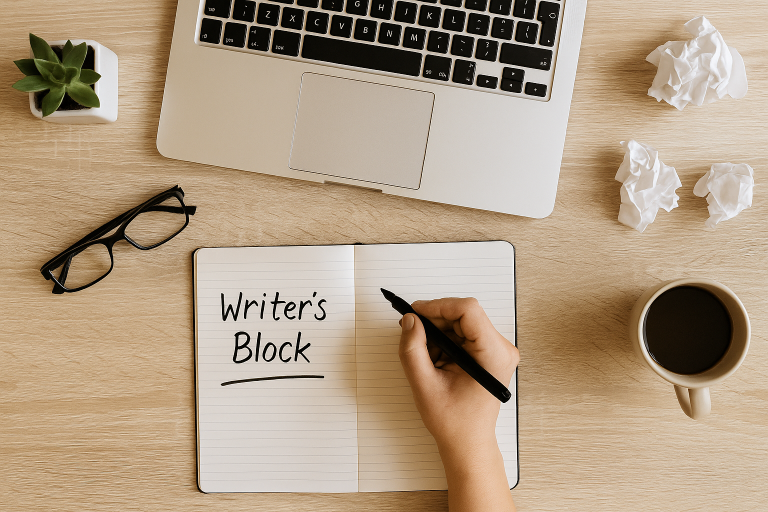
Let’s be real—writer’s block isn’t just frustrating, it can feel paralyzing. One day you’re immersed in your fictional world, your characters are practically writing the story themselves, and the next… nothing. Just silence. A blank page and a blinking cursor that seems to mock every stalled thought.
I’ve faced writer’s block during nearly every major project—especially when writing Echoes of Elsewhere, with its fractured timelines and emotionally heavy themes. Through trial, error, and plenty of creative detours, I’ve discovered that the key isn’t to avoid writer’s block—it’s learning how to move through it without losing momentum.
Here’s how I do it, step by step:
Table of Contents
1. I Step Away—On Purpose
When I hit a wall, I don’t try to fight my way through it immediately. That used to be my go-to tactic: stare harder, type anything, pace and mutter until a sentence landed. But now, I give myself permission to step away intentionally.
I’ll go for a walk, take a shower, or fold laundry—something physical but low-effort that lets my mind wander. More often than not, a breakthrough happens when I’m not trying to force one. It’s like the subconscious starts working the puzzle in the background. Don’t underestimate the creative power of letting go.
2. I Write Something Smaller
When the scene I’m working on feels impossible, I shift focus. I’ll jot down a few lines of dialogue, write a character journal entry, or draft a future moment I’ve been looking forward to. I remind myself: Not everything has to be perfect. Not everything has to make the final draft.
By writing something small, I’m still engaging with the story world—just from a lower-pressure angle. It keeps the momentum alive and often unlocks new insight I didn’t expect.
3. I Change the Medium
Sometimes, it’s not the story that’s stuck—it’s the format.
If I’ve been staring at a screen for too long, I grab a notebook and a pen. Something about writing longhand feels raw, personal, and less polished, which is perfect for free-flowing ideas. I might sketch out a scene map, scribble emotional notes about a character’s internal conflict, or even doodle a symbolic object from the story.
This shift in medium activates a different part of my creative brain—and that can be just enough to break the block.
4. I Revisit My “Why”
Every story begins with an idea that lights a fire in you. When I feel disconnected, I go back to that origin spark:
Why this story?
Why this character?
Why does this matter to me?
I’ll reread old notes, revisit my inspiration board, or even review the playlist I created for the book. These aren’t just creative tools—they’re emotional anchors. Reconnecting with the “why” helps me realign with the heart of the story.
5. I Let Bad Words Happen
This is a big one: I allow myself to write badly.
Writer’s block is often tied to perfectionism. If I feel like every line needs to be brilliant, I’ll freeze. But when I give myself permission to write messy, clunky, first-draft sentences—something shifts. I stop trying to impress and start trying to explore.
Often, it’s in those “bad” lines that I stumble across something raw and real. Something I can polish later. But first, I just have to get it on the page.
6. I Use a Creative Buffer Scene
Not every scene flows easily—especially if it’s emotionally heavy or plot-critical. When I hit a scene that makes me want to close the laptop, I skip ahead.
I write a “creative buffer scene”—something emotionally lighter, something that excites me. It might be a romantic moment, a witty exchange, or a dream sequence I haven’t figured out yet. This keeps me writing while giving my brain space to work out the harder stuff in the background.
7. I Accept the Pause Without Guilt
This one took me years to learn: rest is part of the process.
Burnout doesn’t help your story. Neither does guilt.
Sometimes, the best way to move forward is to stop pushing and give yourself time. I don’t always need to “fix” writer’s block. I just need to be patient with it. Trusting that the story will return makes all the difference.
Final Thoughts
Writer’s block doesn’t mean you’ve failed as a writer. It doesn’t mean your story isn’t worth finishing. It just means your creative process needs a pause, a shift, or a breath.
Whether I’m outlining my next sci-fi scene or rewriting emotional character beats, these tools help me keep going—at my own pace, in my own rhythm. Because momentum isn’t always about speed. Sometimes, it’s just about not stopping.
If you’re stuck right now, try one of these strategies—and remind yourself: the story isn’t gone. It’s just waiting for you to find a new way in.
